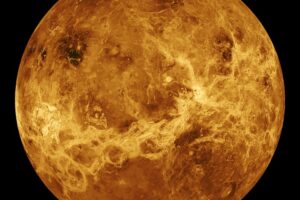Neptune, the eighth and farthest planet from the sun in our solar system, is a mysterious and intriguing world that has captured the imagination of astronomers and space enthusiasts for centuries. Despite its distance from Earth and the challenges of exploring the outer reaches of our solar system, scientists have made significant advancements in understanding this enigmatic planet.
First discovered in 1846 by German astronomer Johann Galle, Neptune is known for its vibrant blue color and turbulent atmosphere, which is filled with swirling clouds and fierce winds that can reach speeds of up to 1,200 miles per hour [1]. The planet is also home to the Great Dark Spot, a massive storm system that is similar in size to Jupiter’s Great Red Spot [2].
One of the most fascinating aspects of Neptune is its complex system of moons, which include Triton, Nereid, and Proteus, among others. Triton, the largest moon of Neptune, is a particularly interesting world, with its icy surface and geysers that spew nitrogen gas into space [3]. Scientists believe that Triton may have been captured by Neptune’s gravity from the Kuiper Belt, a region of icy bodies beyond the orbit of Neptune [4].
Exploring Neptune and its moons is a challenging endeavor, due to the extreme distance and harsh conditions of the outer solar system. However, advancements in space technology have made it possible for spacecraft to venture to these distant worlds and gather valuable data about their composition, atmosphere, and geology.
One notable mission to Neptune was NASA’s Voyager 2 spacecraft, which flew by the planet in 1989 and provided valuable insights into its atmosphere, magnetic field, and moons [5]. More recently, the New Horizons spacecraft, which conducted a flyby of Pluto in 2015, is set to continue its journey towards the outer reaches of our solar system and may provide new discoveries about Neptune and its moons in the future [6].
As we continue to push the boundaries of space exploration, the study of Neptune and the outer solar system will remain a top priority for astronomers and scientists seeking to unlock the secrets of our universe. By delving deeper into the mysteries of Neptune, we can gain a better understanding of the evolution of our solar system and the diversity of worlds that exist beyond our own.
In conclusion, exploring Neptune and its moons is a fascinating journey that offers valuable insights into the outer reaches of our solar system. By utilizing the latest advancements in space technology, scientists are able to uncover the secrets of this distant world and expand our knowledge of the cosmos. As we look towards the future, it is clear that the exploration of Neptune will continue to inspire and captivate us for generations to come.
[1] Source: https://solarsystem.nasa.gov/planets/neptune/overview/[2] Source: https://www.space.com/16123-neptune-planet-great-dark-spot.html
[3] Source: https://solarsystem.nasa.gov/moons/neptune-moons/triton/in-depth/
[4] Source: https://solarsystem.nasa.gov/planets/neptune/in-depth/
[5] Source: https://www.jpl.nasa.gov/voyager/
[6] Source: https://www.nasa.gov/mission_pages/newhorizons/main/index.html






























Add Comment